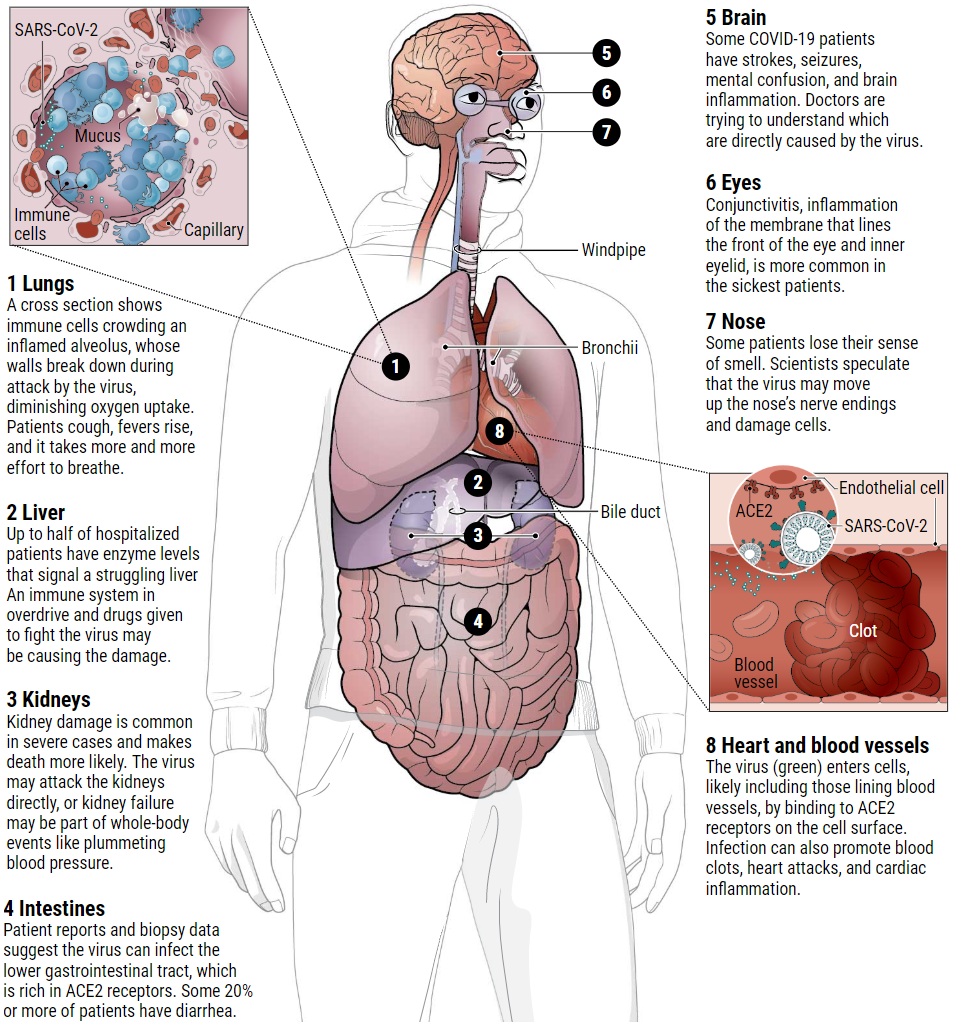每日外闻83
How does coronavirus kill? -10
感染肠道2
病毒在消化道的存在增加了其通过粪便传播的令人不安的可能性。但目前还不清楚粪便中是否含有完整的、传染性的病毒,还是只含有RNA和蛋白质。爱荷华大学的冠状病毒专家Stanley Perlman说,迄今为止,“我们没有证据”表明粪便传播是一条很重要的途径。美国疾病控制与预防中心表示,根据SARS和导致中东呼吸综合征病毒(新型冠状病毒的另一个危险近亲)的经验,COVID-19通过粪便传播的风险可能较低。
肠道并不是疾病在体内传播的终点。例如,多达三分之一的住院病人患结膜炎-眼睛发红、流泪,尽管还不清楚这种病毒是否会直接侵入眼睛。其他报告则显示病毒导致肝损伤:在中国两个住院中心的COVID-19患者中,超过一半的人体内的酶水平升高,这表明肝或胆管受到了损伤。但是一些专家告诉《科学》杂志,病毒的直接入侵不太可能是罪魁祸首。他们说,身体机能衰竭时发生的其他事件,如药物或免疫系统超负荷,更有可能导致肝损伤。
以上这些还只是COVID-19对人体造成的破坏的大概。要想弄清楚它的影响范围,以及它可能引发的一系列心血管和免疫系统的级联效应,将需要花费多年的艰苦研究。随着科学的飞速发展,从显微镜下的组织探测到病人身上的药物测试,人们希望找到一种比能使世界都偏离原来的轨道的病毒更加“狡猾”的治疗方法。
Reaching the gut-2
The presence of virus in the GI tract raises the unsettling possibility that it could be passed on through feces. But it’s not yet clear whether stool contains intact, infectious virus, or only RNA and proteins. To date, “We have no evidence” that fecal transmission is important, says coronavirus expert Stanley Perlman of the University of Iowa. CDC says that based on experiences with SARS and with the virus that causes Middle East respiratory syndrome, another dangerous cousin of the new coronavirus, the risk from fecal transmission is probably low.
The intestines are not the end of the disease’s march through the body. For example, up to one-third of hospitalized patients develop conjunctivitis—pink, watery eyes—although it’s not clear that the virus directly invades the eye. Other reports suggest liver damage: More than half of COVID-19 patients hospitalized in two Chinese centers had elevated levels of enzymes indicating injury to the liver or bile ducts. But several experts told Science that direct viral invasion isn’t likely the culprit. They say other events in a failing body, like drugs or an immune system in overdrive, are more likely driving the liver damage.
This map of the devastation that COVID-19 can inflict on the body is still just a sketch. It will take years of painstaking research to sharpen the picture of its reach, and the cascade of cardiovascular and immune effects it might set in motion. As science races ahead, from probing tissues under microscopes to testing drugs on patients, the hope is for treatments more wily than the virus that has stopped the world in its tracks.
See you tomorrow



